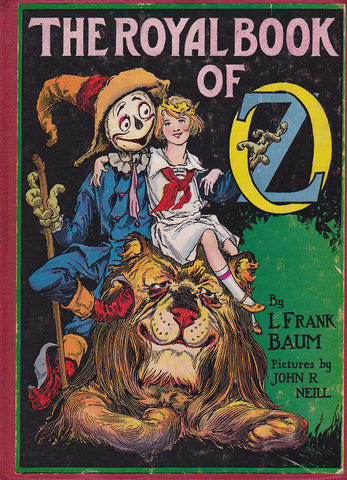 VISIT
MUSEUM STORE
MEMBERSHIP
OZ NEWS
CONTACT
VISIT
MUSEUM STORE
MEMBERSHIP
OZ NEWS
CONTACT
“Ruth Plumly Me!” – The Most Prolific Royal Historian of Oz
Wamego # 63
Jan 1, 2016
“Ruth Plumly Me!” – The Most Prolific Royal Historian of Oz


[Above left: John R. Neill’s front-cover illustrations for the first two Oz books written by Ruth Plumly Thompson: THE ROYAL BOOK OF OZ (1921) and KABUMPO IN OZ (1922). Though the former was credited to L. Frank Baum and only “Enlarged and Edited” – per the actual title page -- by RPT, the entire text was her own. The dual billing was conceived by publishers Reilly & Lee to effect a smooth transition between Baum’s Ozian authorship and that of Thompson; he had died in 1919, and his two final Oz titles were posthumously published, later that year and in 1920. She then and most happily took up the Ozzy gauntlet and penned nineteen Oz books between 1921 and 1939 – more than any other “Royal Historian.”]
What to write to bring in the New Year?
Or, more accurately: What I read to bid “farewell” and “many thanks!” to 2015!
Somehow, over this past week, I’ve found myself very joyously drifting off to Oz. There are historical and personal foundations for such an emotional jaunt, but until l commenced this particular blog and began to reflect, they certainly were subconscious on my part. Regardless of rationale, however, I gravitated these past few days to the shelves here that display my (very) well-worn reading copies of the series. These editions were those l received between – as I recall it -- my eighth birthday and my twelfth Christmas, with the December holidays across that time invariably providing a special treasure-trove of gift volumes. (I think my Ozziest December 25th saw the unwrapping of six of ’em!)
Speaking historically and more universally, Christmas time meant a brand new Oz book under the tree for uncountable thousands of readers in, specifically, thirty-six of the forty-three years between 1900 and 1942. (Four additional, “official” titles appeared between 1946 and 1963.) L. Frank Baum discovered and reported the history of the magic land through the first fourteen books. John R. Neill, who illustrated the second through thirty-fifth tomes, also wrote the last three of those. Then Jack Snow wrote two, and Rachel Cosgrove and Eloise Jarvis McGraw -- the latter with daughter Lauren Lynn McGraw -- each wrote one.
But the most prolific of the Oz series writers was a Pennsylvania gal whose style was ebullient, whose craft was frolicsome, whose sense of fun and pun was omnipresent, whose creativity seldom (if ever) flagged, and whose purpose/goal/desire was – quite simply -- to engage, enliven, and entertain. This won’t be a biographical sketch; those can be sought elsewhere. Rather, this is a quiet celebration of a woman whose writing brought pretty much nonstop and immeasurable elation to my youth, and who continues to actively hold my heart and imagination to this day…whenever I pick up one of her books.
Ruth Plumly Thompson wrote nineteen of the official Oz series. Later on, The lnternational Wizard of Oz Club, lnc. (ozclub.org) published two further Thompson Oz stories, the second of which was issued posthumously. Among others of her titles, I reread those last two volumes this week for the first time in ages: YANKEE IN OZ (1972) and THE ENCHANTED ISLAND OF OZ (1976).
My faint recollection of both was pleasant, but such lightweight regard did them a disservice. ln my current casual return, it became quickly obvious that Ruth – to the end of her life – maintained the discipline, focus, and undeniable love of her gift to well-weave a yarn. As with her earlier work, those concluding efforts convey a merry sense of excitement and play throughout the adventures she recounts. And as in the very best of tales of Oz, the reader gets a happy sense of traveling on their journeys with her protagonists.


[Above: The front and rear covers of THE BAUM BUGLE for Autumn 1976, honoring “RPT” who’d passed away on April 6th of that year. The brilliant Dick Martin art showcases a number of Thompson’s original additions to the galaxy of Oz citizenry (front row: wooden doll Peg-Amy, Pigasus the flying and poetical pig, Jinnicky the Red Jinn, Peter the Philadelphia boy, with Roger The Read Bird on his shoulder; second row: “Humpy” the stuffed, silent-film, stunt-dummy double, Sir Hokus of Pokes, Captain Samuel Salt, Carter Green the Vegetable Man; rear: Kabumpo, the Elegant Elephant of Oz). The photograph shows Ruth with dog Taffy.]
We never met, although l lived a short two-hour train ride away from her suburban Philadelphia home for the last eighteen months or so of her life. But my pleasure this week in revisiting her talent led me to dig through a filing cabinet and pull out the dozen or so letters and cards she sent in response to my pre-teen, teenage, and young adult fervor in the years between 1963 and 1975. Her comments alternate between light and airy, encouraging and reflective, complimentary and delighted – and cover topics ranging from her ongoing plethora of mail from Oz fans (guilty as charged here…), to her new apartment (“a prize; biggest bonus: air conditioning, and another plus: the swimming pool”), the weather (“March – thank Pete – is gone – not much snow but fifty and sixty mile gusts that nearly blew me over the swimming pool”), her attendance at her first Oz Club Convention and her quiet gratification at being honored with the Club’s L. Frank Baum Memorial Award (“…medal now hanging high. l should say plaque, a really handsome piece”), and her pride in niece Dottie’s “two young children[:] Doug now 3 ½ and Debbie 8 mos. Keep things pretty lively.”
Reviewing our brief, sporadic correspondence brought nostalgia, warmth, and gratitude – and a new (or, at least, renewed) realization of her ongoing perceptions about things that meant the most to me. She exulted both when I got the lead in a high school musical and (sometime later) started presenting one-man concerts. She spontaneously wrote to congratulate my own Oz Club writings -- and expressed special satisfaction over a piece I’d done about her non-Oz books. In such reactions, she was (I’m sure) being supremely and professionally courteous, but in the process, there’s no doubt she knew the good her words would do for a fledgling journalist and entertainer. This was, after all, commendation and positive feedback from a writer who’d done SO much to inform and contribute to my own passion for reading and writing -- and my aspirations to communicate.
Our talks about Oz were almost tangential, but in time (if not in detail) we covered my own favorite of her works (CAPTAIN SALT IN OZ, 1936); her wait-and-see approach to an announced 1963 feature-length Oz cartoon (as it didn’t appear until a decade later, she was both savvy and omniscient); her frustration with her publishers for letting her Oz titles drift out-of-print (“Reilly & Lee are a pain in the ear…just plain stupid”); her enthusiasm for some of Baum’s non-Oz writing (“SKY ISLAND was a favorite of mine, and [I] read QUEEN ZIXI OF IX in ST. NICHOLAS [magazine] when I was a little girl”]; and her thankfulness for her fans (“appreciation and letters...are and have been the biggest bonus in a long career and especially so re: Oz”).


[Above: My personal favorite of Thompson’s Oz output has always been CAPTAIN SALT IN OZ (1936); curiously, it’s the only one of the forty “official” Oz books that takes place entirely outside The Land of Oz itself. If I‘m correctly remembering, JACK PUMPKINHEAD OF OZ (1929) and KAMBUMPO IN OZ (1922; see above) were the first Thompson titles I received as a boy; ‘twas Christmas 1958.]
So here’s to all these decades of “reveling in Ruth.” This week, she provided an unexpected and totally magical sojourn into Oz, into my own past life – and she has carried me, smiling, into 2016. I took additional joy in reviewing the signatures of her communications, and I’m sure every “vintage” Oz fan who received one or some of the tens of thousands of letters she answered will recognize such finales as “Ruth Plumly T,” “Ruth Plumly T -- and the Wizard!,” “Ruth ’n Yankee,” “Same old RPT,” “Ruth Plumly Me,” and “I love you, too! Surely do. Ruth.”
God bless her on her eternal road to Oz. How fortunate we are that she took us along!
Article by John Fricke





